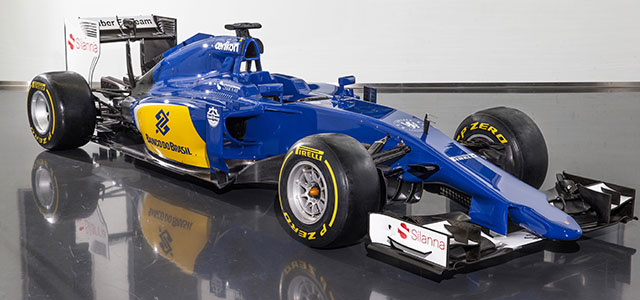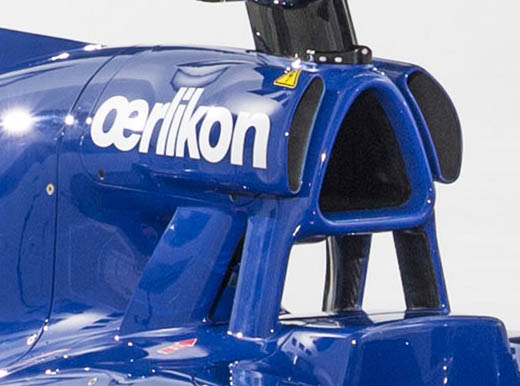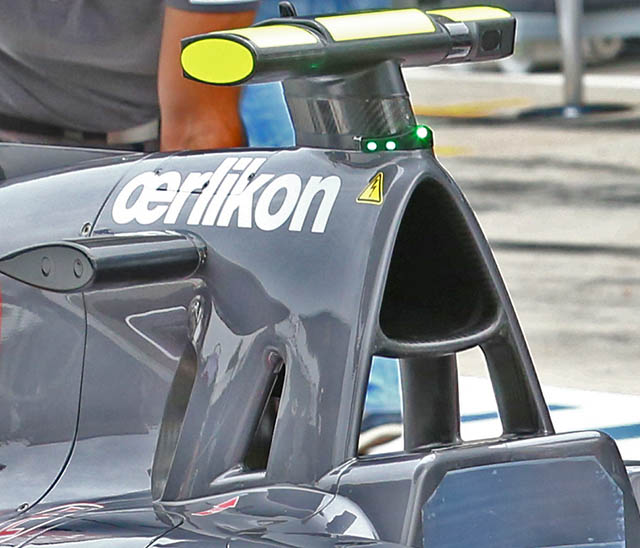
Sauber’s 2014 season was a disaster. The Swiss team is making no secret of its problems, and discussed them in depth in early 2015 with Racecar Engineering (see link at the base of the page). So its new car, the C34 would have to be a lot better than the C33…
With regard to the 2015 season, team principal Monisha Kaltenborn said: “2014 was a very disappointing year. However, this is in the past, and we now focus on what comes next. We have learned our lessons and are confident for the new season.”
After a season with the most comprehensive technical changes in the history of Formula One, there are significantly fewer regulation changes for the 2015 season. During the development of the new Sauber C34-Ferrari the Sauber F1 Team’s engineers focused on three areas: performance in slow corners, weight reduction, as well as braking stability.
Eric Gandelin, chief designer of the Sauber F1 Team, explained: “We were able to gain a lot of experience during the course of the 2014 season, which will have an influence on the Sauber C34.”
Aerodynamics traditionally play a key role in the development of a new car. But on this occasion it wasn’t only a question of optimising downforce and drag, but also improving the balance of the car and its responses in particular through low-speed corners.
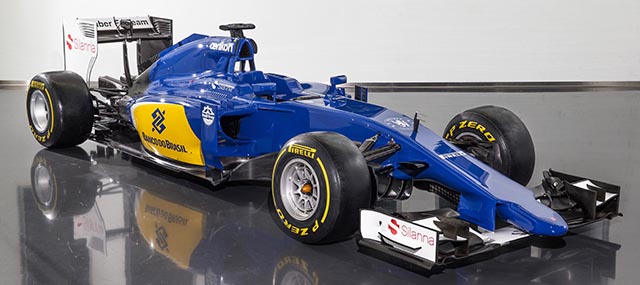
The greatest visual difference compared to the Sauber C33 can be found around the nose section, which is now bigger in volume and lower to the ground following further changes to the technical regulations. This has a considerable impact on the aerodynamics of the entire car: the nose and front wing play a key role in determining how the air flows around the front wheels and how effectively the central and rear sections of the car function aerodynamically. The new design of the wheel rims has progressed in a similar direction, in the interests of optimising airflow around the front wheels.
The front suspension concept has changed little, with the springs and dampers again pushrod-actuated. However, the engineers put a lot of effort into improving the feedback from the steering for the drivers.
The sidepods of the new Sauber C34, however, are now slimmer than those of the Sauber C33, despite higher cooling requirements from the new power unit. This has been made possible by modifications to the attachment of the side crash elements. In addition, the architecture of the radiators, which are now positioned horizontally, has been fundamentally revised. The engineers also paid great attention to the flexibility of the cooling system, which can be adapted precisely – and individually for the various components – to the ambient temperature and circuit characteristics. For example, small air vents on the side of the cockpit are only used in certain situations.
Beyond this, the rear section as a whole smaller, which benefits aerodynamic efficiency.
The car’s minimum weight has been increased in line with the FIA’s technical regulations, up from 691 kg a year ago to 702 kg now. The engineers, of course, set out to undercut this figure in order to give themselves ample room for manoeuvre when it comes to weight distribution – an important factor in determining how the car uses its tyres.
Modified powertrain
The car’s engine, energy recovery system and gearbox are again supplied by Ferrari. The 1.6-litre turbocharged V6 engine has a rev limit of 15,000 rpm. The technical regulations allow for certain components to be completely redesigned for the 2015 season. The aim has been not only to increase the power from the turbocharged engine, but above all to optimise the car’s energy recovery and energy storage capability.
In terms of its concept, the engine is very much comparable with last year’s, but its architecture has changed significantly, necessitating numerous adjustments to the chassis.
The exhaust tailpipe is again positioned centrally between two pylons, though they are no longer supported by the rear crash element, but by the gearbox housing.
The spring and damper elements at the rear axle are again pullrod-actuated, but otherwise this is a totally new construction with separate lower wishbone legs. In addition, the engineers worked on improving the mechanical traction. Besides a number of other parts, there will be optimised gear ratios to support this effort.
As with its predecessor, the packaging of the C34 presented the engineers with a genuine challenge. After all, in excess of 40 electronics boxes have to be accommodated, of which more than 30 require cooling.
A first impression of the value of these measures will be obtained at the first test in Jerez. “Later on it will be crucial to see where we stand in comparison to our competition,” explained chief designer Eric Gandelin.
The Sauber F1 Team will use a roll-out version of the car for the first test at Jerez. Some components are still from the C33 and will be successively replaced by new parts. “We will use the time up to Melbourne to ensure we’re as competitive as possible when we line up on the grid for the season opener,” added Eric Gandelin.
Analysis
The C34 features some interesting ducting around the roll hoop, most obviously the car has grown ‘ears’, these additional ducts cool systems toward the rear of the car, likely the transmission and possibly the MGU-K.
The main triangular duct basically carries over from 2014 and feeds the engine combustion air. Beneath it lie two more ducts of unknown purpose, but likely cooling electrical components.
Overall the roll hoop concept of the C34 carries over from the C33, and aside from some blue paint and the ‘ears’ seems to be otherwise identical. It is interesting that it does not feature the long air box of the Ferrari which has an identical power unit. Compares the 2015 roll structure (above) with the 2014 (below) and at first glance it is hard to tell them apart. But the 2015 version is a slightly more regular shape and the front legs are narrower.
This is a concept that was brought to Sauber by James Key some years ago after he first tried it out at Force India (below)
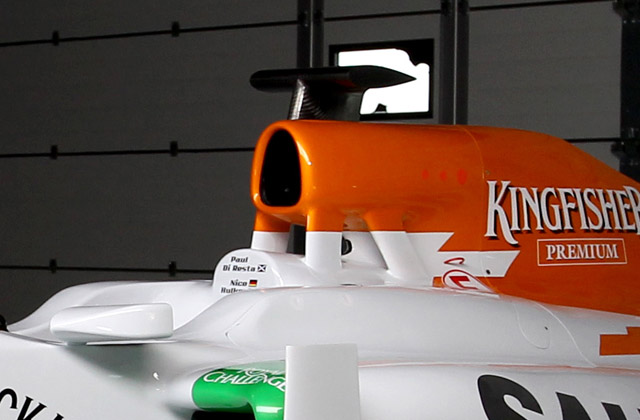
On the engine cover the C34 carries over the turbocharger cooling ducts seen on the C33, Ferrari also has a similar solution. Note the large panel gap, this is likely a symptom of a car bodged together for a photo shoot rather than indicative of the final product.

The side pod ducts on the Sauber are interesting, they seem to be generally the same size as in 2014 but the upper lip clearly shows the distinct bulge of the side impact structure.
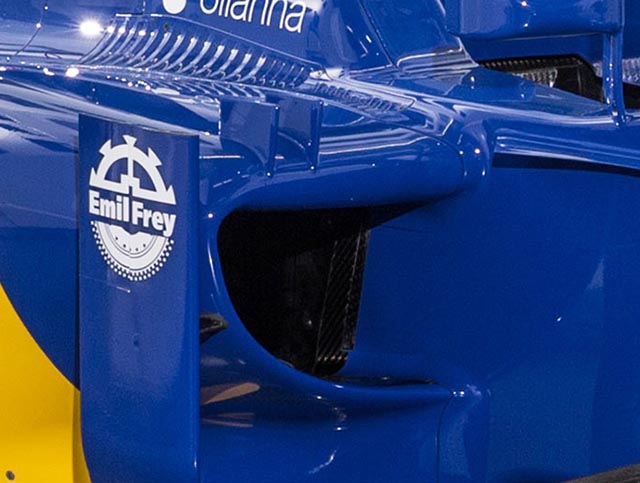
Compare the complete 2015 intake (above) with a stripped down 2014 version (below) clearly showing the side impact structure location. Note the turning vanes on the 2015 version, and just visible the optional cooling louvres.
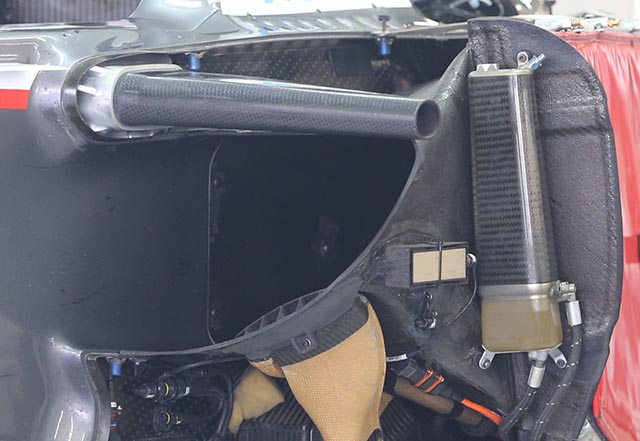
A look at the front of the Sauber shows that the team have opted for the gradual gradient nose solution.
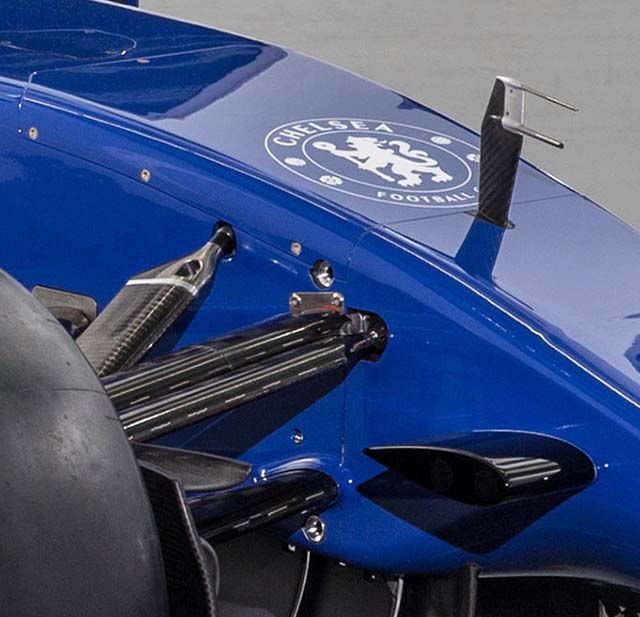
A bonnet cover or vanity panel similar to those used in F3 covers some suspension components, while the smaller than typical front bulkhead carries the brake master cylinders. Some of the front suspension components may pick up on forward projections.
Taking a closer look at the Sauber C34 during pit stop practice at Jerez a few more details become apparent. Looking at the right hand side, side pod duct other ducts within the main duct become apparent. The scoop at the base of the duct is clear to see (and also is a feature of the LHS duct) and likely cools the many electronic boxes located under the bodywork at this point. Less obvious is a small cooling slit on the ducts inner edge. This aperture features a small vane in its lower portion suggesting that this slit duct feeds air to at least two internal components, including possibly the battery.
On the upper part of the outer edge of the side pod a small protrusion can be seen in the image above, this lump houses the side impact structure, it features on a number of cars some of which use it to support the side pod mounted turning vanes.
A number of electronic control boxes are mounted inside the cockpit of the C34. These tend to only be visible with the seat removed, the Magneti Marelli boxes likely relate to the operation and control of the Ferrari power unit. None of the standard McLaren control boxes are visible here, but these tend to be located elsewhere on the car.
A look at the rear of the C34’s steering wheel reveals the paddle arrangement, these can be programmed according to driver preference to some extent.
The Sauber has perhaps the largest amount of centreline cooling louvres of any 2015 car. Generally openings on the bodywork for any purpose are outlawed but in the area where these louvres are fitted there is some freedom and most teams exploit it for additional cooling.
The rear of the car is seemingly largely made out of Textreme’s spread tow material with its distinctive chequerboard pattern. Note the material added on top of the rear crash structure and how it is shaped to channel the exhaust plume. On the inner faces of the twin rear wing supports there is a substantial metallic heat shield to cope with the heat from the cars exhaust pipe. The pipe itself appears to be supported by the crash structure rather than the transmission casing. Finally note the end fence on the rear crash structure, an aerodynamic part likely used to improve diffuser performance.
The reverse of that view reveals some details of the diffuser layout and the air dam around the rear crash structure. Sauber has put the driveshaft inline with the lower rear wishbones. Note the rear wheel tethers picking up on the crash structure. The inboard upper rear wishbone pickup is also evident on top of the crash structure with the exhaust support sharing the same assembly.
On closer inspection the exhaust support is separate from the suspension mounting mounted just rearward of it.
A look at the tip of the cars nose reveals how large it is (possibly the largest of all 2015 cars) and how close it sits to the central section of the front wing.
Under the main nose structure there is a metal element, it looks like it features rudimentary heat sinks suggesting that some electronic component is mounted here. Curiously it appears to be on the removable nose section rather than the chassis. Further investigation is needed!
The front brake ducts have become more crucial than ever with the introduction of the new noses in 2015. Air flow in this region is critical to overall car performance. Here is Saubers initial brake duct and winglet solution, expect this to change as it is a major area of development, indeed looking at the material used it appears to be from the CRP Windform family, suggesting that in fact it has been produced in a very short time indeed.

